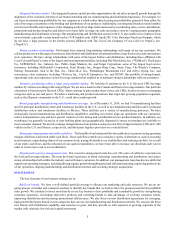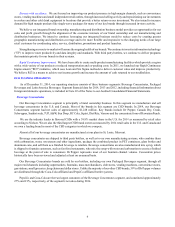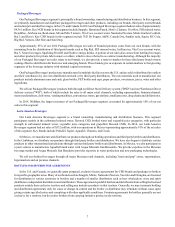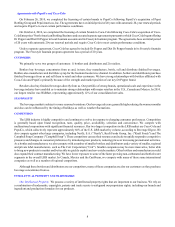Snapple 2014 Annual Report Download - page 18
Download and view the complete annual report
Please find page 18 of the 2014 Snapple annual report below. You can navigate through the pages in the report by either clicking on the pages listed below, or by using the keyword search tool below to find specific information within the annual report.
15
Our total indebtedness, excluding capital lease obligations, could affect our operations and profitability.
We maintain levels of debt we consider prudent based on our actual and expected cash flows. As of December 31, 2014, our
total indebtedness was $2,591 million.
This amount of debt could have important consequences to us and our investors, including:
• requiring a portion of our cash flow from operations to make interest payments on this debt; and
• increasing our vulnerability to general adverse economic and industry conditions, which could impact our debt maturity
profile.
While we believe we will have the ability to service our debt and will have access to additional sources of capital in the future
if and when needed, that will depend upon our results of operations and financial position at the time, the then-current state of the
credit and financial markets and other factors that may be beyond our control.
We depend on key information systems and third party service providers.
We depend on key information systems to accurately and efficiently transact our business, provide information to management
and prepare financial reports. We rely on third party providers for a number of key information systems and business processing
services, including hosting our primary data center and processing various benefit-related accounting and transactional services.
These systems and services are vulnerable to interruptions or other failures resulting from, among other things, natural disasters,
terrorist attacks, software, equipment or telecommunications failures, processing errors, computer viruses, other security issues
or supplier defaults. Security, backup and disaster recovery measures may not be adequate or implemented properly to avoid such
disruptions or failures. Any disruption or failure of these systems or services could cause substantial errors, processing inefficiencies,
security breaches, inability to use the systems or process transactions, loss of customers or other business disruptions, all of which
could negatively affect our business and financial performance.
As cybersecurity attacks continue to evolve and increase, our information systems could also be penetrated or compromised
by internal and external parties intent on extracting confidential information, disrupting business processes or corrupting
information. These risks could arise from external parties or from acts or omissions of internal or service provider personnel. Such
unauthorized access could disrupt our business and could result in the loss of assets, litigation, remediation costs, damage to our
reputation and failure to retain or attract customers following such an event, which could adversely affect our business.
Litigation or legal proceedings could expose us to significant liabilities and damage our reputation.
We are party to various litigation claims and legal proceedings which may include employment, tort, real estate, commercial
and other litigation. From time to time we are a defendant in class action litigation, including litigation regarding employment
practices, product labeling, and wage and hour laws. Plaintiffs in class action litigation may seek to recover amounts which are
large and may be indeterminable for some period of time. We evaluate litigation claims and legal proceedings to assess the likelihood
of unfavorable outcomes and estimate, if possible, the amount of potential losses. We will establish a reserve as appropriate based
upon assessments and estimates in accordance with our accounting policies. We base our assessments, estimates and disclosures
on the information available to us at the time and rely on legal and management judgment. Actual outcomes or losses may differ
materially from assessments and estimates. Costs to defend litigation claims and legal proceedings and the cost of actual settlements,
judgments or resolutions of these claims and legal proceedings may negatively affect our business and financial performance. Any
adverse publicity resulting from allegations made in litigation claims or legal proceedings may also adversely affect our reputation,
which in turn could adversely affect our results.
Certain raw materials we use are available from a limited number of suppliers and shortages could occur.
Some raw materials we use, such as aluminum cans and ends, glass bottles, PET bottles, sweeteners, fruit, juice and other
ingredients, are sourced from industries characterized by a limited supply base. If our suppliers are unable or unwilling to meet
our requirements, we could suffer shortages or substantial cost increases. Changing suppliers can require long lead times. The
failure of our suppliers to meet our needs could occur for many reasons, including fires, natural disasters, weather, manufacturing
problems, disease, crop failure, strikes, transportation interruption, government regulation, political instability, cybersecurity
attacks and terrorism. A failure of supply could also occur due to suppliers' financial difficulties, including bankruptcy. Some of
these risks may be more acute where the supplier or its plant is located in riskier or less-developed countries or regions. Any
significant interruption to supply or cost increase could substantially harm our business and financial performance.
























